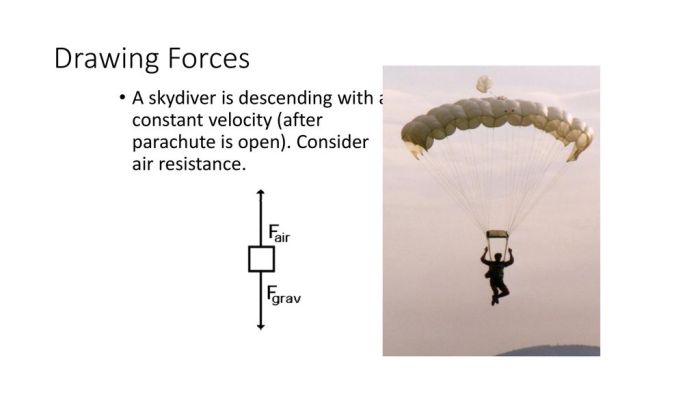A downward-moving skydiver is falling with a constant speed, a phenomenon governed by the intricate interplay of forces acting upon the skydiver. This article delves into the fascinating world of skydiving, examining the factors that determine a skydiver’s constant speed and its implications for the sport and beyond.
As a skydiver plummets towards the earth, they encounter a myriad of forces that shape their trajectory. Gravity, the relentless pull of the earth, draws them downwards, while air resistance, the opposing force generated by their movement through the air, acts to slow their descent.
These forces reach an equilibrium, resulting in the skydiver’s constant speed.
Introduction

A skydiver falling with constant speed is a situation where the downward force of gravity is exactly balanced by the upward force of air resistance. This results in the skydiver maintaining a constant velocity as they descend.
The forces acting on a skydiver are gravity, which pulls the skydiver down, and air resistance, which opposes the skydiver’s motion.
Factors Affecting Constant Speed
The skydiver’s constant speed is affected by several factors, including:
- Air resistance:Air resistance is the force that opposes the skydiver’s motion. It is caused by the interaction between the skydiver’s body and the air molecules. The greater the air resistance, the slower the skydiver will fall.
- Gravity:Gravity is the force that pulls the skydiver down. The greater the force of gravity, the faster the skydiver will fall.
These factors interact to determine the skydiver’s constant speed. When the force of air resistance is equal to the force of gravity, the skydiver will fall with constant speed.
Terminal Velocity, A downward-moving skydiver is falling with a constant speed
Terminal velocity is the constant speed at which a skydiver falls when the force of air resistance is equal to the force of gravity. The terminal velocity of a skydiver depends on their weight, shape, and the density of the air.
The formula for calculating terminal velocity is:
v = √(2mg/ρAC)
where:
- v is the terminal velocity
- m is the mass of the skydiver
- g is the acceleration due to gravity
- ρ is the density of the air
- A is the cross-sectional area of the skydiver
- C is the drag coefficient
Skydiver’s Position and Acceleration
As a skydiver falls with constant speed, their position changes, but their acceleration is zero. This is because the forces acting on the skydiver are balanced.
The skydiver’s speed is constant, but their altitude is decreasing. The rate at which the skydiver’s altitude decreases is equal to their constant speed.
Applications and Examples
Understanding a skydiver’s constant speed is important for skydiving and other activities involving freefall. By understanding the factors that affect constant speed, skydivers can control their descent and land safely.
For example, a skydiver can increase their air resistance by spreading their arms and legs. This will slow their descent and allow them to land more softly.
Quick FAQs: A Downward-moving Skydiver Is Falling With A Constant Speed
What factors affect a skydiver’s constant speed?
Air resistance and gravity are the primary factors that determine a skydiver’s constant speed.
What is terminal velocity?
Terminal velocity is the constant speed reached by a skydiver when the force of air resistance equals the force of gravity.
How does a skydiver’s altitude affect their speed?
As a skydiver descends, the air becomes denser, increasing air resistance and causing their speed to decrease.



